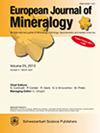大理石中锆石的多重生长(缅甸莫谷变质带):偏碳酸盐系统中流体变质作用和锆钛锆石成矿作用的证据
IF 1.7
3区 地球科学
Q2 MINERALOGY
引用次数: 0
摘要
摘要。流体渗入(元)碳酸盐岩是一个重要的岩石学过程,可诱发变质脱碳和潜在的金属或非金属矿化。确定反应流体的渗透时间和成分特征对于了解流体与岩石相互作用的机制和过程至关重要。锆英石(理想公式:CaZrTi2O7)是一种重要的含铀附属矿物,可在元碳酸盐岩中发育。在这项研究中,我们调查了缅甸莫谷变质岩带白云石大理岩中流体渗入反应区中各种类型锆英石的出现、质地、成分和年代学。锆英石有三种类型:(1) 第一种类型(Zrl-I)与偏硅酸盐和氧化物矿物(绿柱石、尖晶石、辉绿岩)共存,成分均匀,二氧化铀(21.37 wt %-22.82 wt %)和二氧化硫(0.84 wt %-1.99 wt %)含量较高。(2) 第二种类型(Zrl-II)的纹理特征与 Zrl-I 相似。然而,Zrl-II 显示出核-边带分带,边带中的二氧化铀含量(平均为 23.5 ± 0.4 wt % (n=8))略高于核(平均为 22.1 ± 0.3 wt % (n=8))。(3) 第三种类型(Zrl-III)通常出现在巴德利石周围的冠层中,与多晶石英共存。Zrl-III 的二氧化铀含量(0.88 重量 %-5.3 重量 %)明显低于 Zrl-I 和 Zrl-II。所有类型的锆英石的稀土元素(REE)含量都相对较低(ΣREE < 480 µg g-1)。三种类型锆英石的微观性质和成分,结合使用激光烧蚀电感耦合等离子体质谱法(LA-ICP-MS)进行的原位锆英石 U-Pb 测定,揭示了白云石大理岩中的偶发性流体渗透和元素移动。第一阶段的渗透发生在 35 Ma ∼ 35 Ma,形成了富镁硅酸盐和氧化物以及附属矿物(Zrl-I、baddeleyite 和 geikielite)。反应流体的特点是 Zr、Ti、U 和 Th 含量高。之后,一些 Zrl-I 晶粒经历了局部流体辅助溶解-沉淀过程,产生了核心-边缘分带(即 Zrl-II 型)。流体渗入的最后阶段发生在 19 Ma ∼ 19 Ma,表现为 Zrl-III 在baddeleyite 之后生长。与第一阶段的浸润流体相比,该阶段的浸润流体中 U 含量相对较低,SiO2 活性较高。这项研究表明,锆英石是一种强大的矿物,可以记录(元)碳酸盐中流体流入、元成岩反应和Zr-Ti-U成矿作用的反复发作(从35 Ma到19 Ma不等)。这种矿物不仅提供了有关流体流动时间的关键信息,还记录了反应流体的化学变化。因此,锆英石有望在描述流体-碳酸盐相互作用、造山运动二氧化碳释放以及稀有金属转移和沉积方面发挥更重要的作用。本文章由计算机程序翻译,如有差异,请以英文原文为准。
Multiple growth of zirconolite in marble (Mogok metamorphic belt, Myanmar): evidence for episodes of fluid metasomatism and Zr–Ti–U mineralization in metacarbonate systems
Abstract. Fluid infiltration into (meta-)carbonate rocks is an important petrologic process that induces metamorphic decarbonation and potential mineralization of metals or nonmetals. The determination of the infiltration time and the compositional features of reactive fluids is essential to understand the mechanism and process of fluid–rock interactions. Zirconolite (ideal formula: CaZrTi2O7) is an important U-bearing accessory mineral that can develop in metasomatized metacarbonate rocks. In this study, we investigate the occurrence, texture, composition, and chronology of various types of zirconolite from fluid-infiltrated reaction zones in dolomite marbles from the Mogok metamorphic belt, Myanmar. Three types of zirconolite are recognized: (1) the first type (Zrl-I) coexists with metasomatic silicate and oxide minerals (forsterite, spinel, phlogopite) and has a homogeneous composition with high contents of UO2 (21.37 wt %–22.82 wt %) and ThO2 (0.84 wt %–1.99 wt %). (2) The second type (Zrl-II) has textural characteristics similar to those of Zrl-I. However, Zrl-II shows a core–rim zonation with a slightly higher UO2 content in the rims (average of 23.5 ± 0.4 wt % (n=8)) than the cores (average of 22.1 ± 0.3 wt % (n=8)). (3) The third type (Zrl-III) typically occurs as coronas around baddeleyite and coexists with polycrystalline quartz. Zrl-III has obviously lower contents of UO2 (0.88 wt %–5.3 wt %) than those of Zrl-I and Zrl-II. All types of zirconolite have relatively low rare earth element (REE) contents (< 480 µg g−1 for ΣREE). Microtextures and compositions of the three zirconolite types, in combination with in situ zirconolite U–Pb dating using laser ablation inductively coupled plasma mass spectrometry (LA-ICP-MS), reveal episodic fluid infiltration and element mobilization in the dolomite marbles. The first-stage infiltration occurred at ∼ 35 Ma, leading to the formation of Mg-rich silicates and oxides and accessory minerals (Zrl-I, baddeleyite, and geikielite). The reactive fluid was characterized by high contents of Zr, Ti, U, and Th. After that, some Zrl-I grains underwent a local fluid-assisted dissolution–precipitation process, which produced a core–rim zonation (i.e., the Zrl-II type). The final stage of fluid infiltration, recorded by the growth of Zrl-III after baddeleyite, took place at ∼ 19 Ma. The infiltrating fluid of this stage had relatively lower U contents and higher SiO2 activities than the first-stage infiltrating fluid. This study illustrates that zirconolite is a powerful mineral that can record repeated episodes (ranging from 35 to 19 Ma) of fluid influx, metasomatic reactions, and Zr–Ti–U mineralization in (meta-)carbonates. This mineral not only provides key information about the timing of fluid flow but also documents the chemical variation in reactive fluids. Thus, zirconolite is expected to play a more important role in characterizing the fluid–carbonate interaction, orogenic CO2 release, and the transfer and deposition of rare metals.
求助全文
通过发布文献求助,成功后即可免费获取论文全文。
去求助
来源期刊
CiteScore
2.80
自引率
9.50%
发文量
40
审稿时长
6-12 weeks
期刊介绍:
EJM was founded to reach a large audience on an international scale and also for achieving closer cooperation of European countries in the publication of scientific results. The founding societies have set themselves the task of publishing a journal of the highest standard open to all scientists performing mineralogical research in the widest sense of the term, all over the world. Contributions will therefore be published primarily in English.
EJM publishes original papers, review articles and letters dealing with the mineralogical sciences s.l., primarily mineralogy, petrology, geochemistry, crystallography and ore deposits, but also biomineralogy, environmental, applied and technical mineralogy. Nevertheless, papers in any related field, including cultural heritage, will be considered.

 求助内容:
求助内容: 应助结果提醒方式:
应助结果提醒方式:


